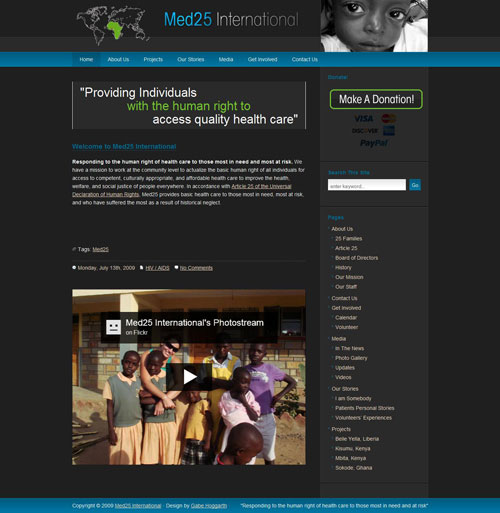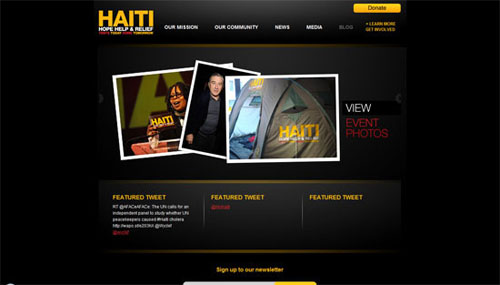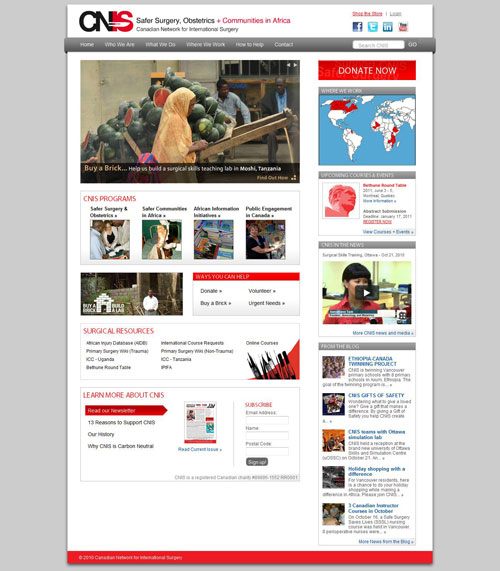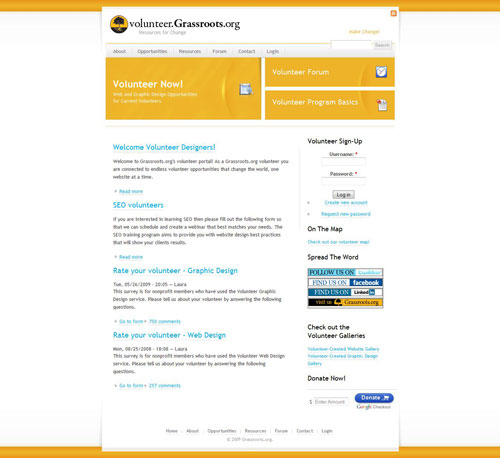- Home
- Blog
- Web Design Volunteer Work in Web Design
Volunteer Work in Web Design
-
 11 min. read
11 min. read
-
 William Craig
William Craig CEO & Co-Founder
CEO & Co-Founder
- President of WebFX. Bill has over 25 years of experience in the Internet marketing industry specializing in SEO, UX, information architecture, marketing automation and more. William’s background in scientific computing and education from Shippensburg and MIT provided the foundation for MarketingCloudFX and other key research and development projects at WebFX.
 Volunteering is an attractive option for every web worker at some point. Whether the motivation is for self-promotion (for example, to broaden one’s network) or purely to help others in difficult times, many of us in the web industry have thought of doing it at least once. What makes us accept or decline an invitation to volunteer our services?
Volunteering is an attractive option for every web worker at some point. Whether the motivation is for self-promotion (for example, to broaden one’s network) or purely to help others in difficult times, many of us in the web industry have thought of doing it at least once. What makes us accept or decline an invitation to volunteer our services?
What is there to gain, and what do we risk? What are the criteria for deciding whether a particular non-paying design job is worth our time and effort? Before determining whether a project is fitting for volunteer work or not, we have to see whether we’d like to be involved in it in the first place.
Weighing the pros and cons and understanding the benefits and risks are essential.
Reasons to Volunteer Your Web Design Services
There are plenty of great reasons to volunteer your valuable time and effort to a cause.
Self-Promotion
Self-promotion and publicity is the primary motivation for big and small companies to volunteer for worthy causes.
Projecting the image of a company that contributes to the well-being of society is a basic principle of marketing. People will favor your services if they sense that your operating plan isn’t based solely on profit. By helping groups and organizations in need, you are showing that you would probably also place the needs of paying clients in high regard.
Of course, you would demonstrate to existing clients that their satisfaction figures largely in how you measure your success, but how would prospective clients know that? Most clients out there have certain apprehensions about service providers. Will the quality of service be sufficient for the money being paid?
Will the designer rush to finish the project as quickly as possible and then walk away once the check comes? When potential customers check your portfolio and see that you’ve volunteered for a few projects, they will feel more assured that you will listen to their needs and not the jingle of change in their pocket. Volunteering also exposes your work to a bigger audience.
You instantly become more approachable to ordinary people with modest means but big dreams. Business owners with small budgets might feel reluctant to step onto the Web. But even a low-budget presence on the web would help them, and you could be there to satisfy that need.
Seeing how well you have served charitable causes, they will assume that you would be more sympathetic to their aspirations versus a company with a portfolio full of expensive, high-profile projects. And these clients might very well stick with you as they grow and scale their business. Big companies are also impressed by volunteer projects, especially successfully executed ones.
They are always on the lookout for inspirational designers who can fulfill their heavy demands, capture their brand and communicate their message to users. Volunteering as a means for self-promotion has its negative side too, though. People might assume you’re willing to do a lot of work for free, or at a much lower price than what you’re worth.
This can happen if you volunteer too much or don’t set out goals and strategies clearly in your discussions with volunteer-based clients. Explain your approach and methods so that clients don’t lead other companies to believe that they can get a golden ticket to your web design services without spending a dime. Your volunteer clients should feel moved to explain to others that you kindly offered to support a cause that you care about, but that you are still a professional and expect fair market wages.
A Chance to Hone Your Skills
Working on a website is never a waste of time, because it is a chance to put your skills and inspiration to work. Certainly, anyone can create sample websites in their free time, but the advantage of a volunteer website is that you get real results from your work. It’s like an academic project: you aren’t paid, but you are graded on it, and there are no better critics than users themselves.
An audience is a huge knowledge base of feedback for your work, and one more project means one more real-time evaluation of your work by real people. You could even implement the newest techniques you’ve learned to see how much they enhance the audience’s experience. Volunteering is also an excellent way for newcomers to the industry to practice their skills and gain experience in client management and self-promotion.
But don’t overdo it. While taking on extra work for practice is usually worthwhile, remember two things:
- Don’t overload your schedule and push back paid projects. Be realistic with your schedule. Paying clients have strict deadlines to meet. This doesn’t mean you should put volunteer work at the bottom of the list.
Rather, work out flexible dates for deliverables so that you can keep pace with paid work.
- Don’t test out too many new ideas on a single project. Radical solutions (such as bleeding-edge layouts and scripts) could end up doing more harm than good for a website. Your goal should be the level of quality you would deliver if you were getting paid for the project.
Boosting Your Portfolio
One of my happier moments is adding a newly completed project to my portfolio. Your portfolio is the demonstration of your skill to the industry at large. Volunteering is a good way to add to a portfolio, prove your worth, get a feel for the profession and attract clients.
Everyone has to start somewhere, and supporting a worthy cause is certainly a good place to begin. You expose a defined audience to your work, you get experience in real-world conditions, and you offer much-needed aid. Awesome all around.
Believe it or not, there’s a risk here, too. Setting a limit on how much work you do for free is crucial. If you’re too soft with people and want to constantly volunteer your services, you might get caught in a financial bind.
While your good intentions are admirable, they won’t make ends meet. For this reason, try to volunteer with people you know well (family and close friends) or recognized charitable groups. Both are more likely to understand your goals and understand that you won’t be doing this free forever.
Spread your wings and take on paid projects as soon as you feel you can handle their requirements (i.e. the strict deadlines, complicated requests, etc.). Filling your portfolio with good deeds is nice, but making a living from it is even nicer.
Picking Out Volunteer Projects
Let’s say you’ve decided that you can volunteer on a few projects. The next step is to figure out whether a particular project qualifies for volunteer work. Three important questions will help you make a decision.
What Is the Main Goal of the Website?
A website for an organization that supports a social cause is worthy of a designer’s efforts, especially if the organization relies entirely on public donations for survival. Still, fund-raising structure isn’t the only element to look for; many websites simply aim to inform the public about a cause. Some worthy causes are disaster relief awareness, programs for people with special needs, animal shelters, online education for children, and cultural and scientific endeavors.
Organizations whose websites have benefited from volunteer help include Med25 International, a health care organization that provides medical aid to countries in need, Hope Help and Relief Haiti by Jacob Cass, and CNIS, which does vital obstetrics work in Africa. 

 A charitable organization exists for every worthy cause, so find something that suits your interests and ideals. Being able to relate to the cause you are supporting will boost your creativity and your desire for quality results.
A charitable organization exists for every worthy cause, so find something that suits your interests and ideals. Being able to relate to the cause you are supporting will boost your creativity and your desire for quality results.
What Is the Nature of the Organization?
In general, aim to volunteer at non-profit organizations. The ones that need your assistance the most are small, local or newly formed groups. You can usually get to know the team well and see whether its motivations are transparent and clear.
You might also want to volunteer for small business ventures that were hit hard by the recent economic downturn. This could be your favorite mom-and-pop store when you were growing up and that have personal sentimental value to you, local businesses that are vital to your neighborhood and community, and so forth. Before you lend a hand, make sure the owners have invested enough time, love and effort to save their business and that they are genuinely in need of aid.
If you do help out, they may call on you when business get better, or at least promote you to their colleagues.
Will Others Be Volunteering as Well?
Before you commit to volunteering on a project, find out whether other web workers will be working on the project, too. You don’t want to reach the middle of a project before finding out that everyone else is getting paid except you.
Avoid organizations that are otherwise willing to pay for services but consider your contribution of low value or that take your kindness and time for granted.
Does Volunteer Work Harm the Web Design Industry?
Volunteering–done in a misguided way–could seriously harm the industry if professional web designers are working on for-profit websites that would otherwise pay for services. This would drive the price of web design work down and make the field unviable for professionals.
That is why it is very important to be selective towards picking the right organizations to work with. However, making a career solely from volunteer work is not viable either (one can do only so many projects for free before going hungry), so the industry is in no real danger of being flooded by free designs. The important thing is to stick to the basic guidelines discussed above: know the nature of the project; favor non-profit organizations; don’t overdo it just to bulk up your portfolio; and make sure the client understands that, as much as you support the cause, your work is still costing you effort and time: two resources you normally get paid for.
Bottom line: Web designers must avoid creating misconceptions about the value of our work. To keep the industry healthy, we must establish clear boundaries between projects that can be considered for volunteer work and projects that should be paid work. But don’t swing in the other direction either.
Don’t go on a rant when taking on volunteer work and brag (or whine) about the money you could have been making by working for a paying project. You are volunteering your services because you want to, and your effort and professionalism should be in the same level as your paid projects.
Last Thoughts
Volunteering is a great way to serve your community, expose your work to a broader audience, build your portfolio, and hone your skills.
Check the parameters of the project before starting, such as the nature of the organization and the people who run it. You should feel comfortable with the team you’ll be collaborating with and the cause you’ll be supporting. Above all, make sure the project is well conceived and targeted at the right audience: web design is your profession, not your pastime.
Finding Volunteer Work Opportunities
To get involved in volunteering, look online or around your area. If you Google “volunteer web designer“, you’ll get a ton of results from groups looking for help to set up a website, and usually for a good cause. There are also websites that focus on connecting tech workers with charitable organizations, including Grassroots.org and IT4Communities (based in the UK).
 You can also look to local public schools, hospitals, community aid organizations and animal welfare groups. You might also find web design opportunities with educational institutions that organize seminars for students, cultural events, fund-raising fairs and public awareness lectures. Here are a few more websites to check out:
You can also look to local public schools, hospitals, community aid organizations and animal welfare groups. You might also find web design opportunities with educational institutions that organize seminars for students, cultural events, fund-raising fairs and public awareness lectures. Here are a few more websites to check out:
- DESIGN 21: Social Design Network
- The Designers Accord
- Architecture for Humanity
- Taproot Foundation
Have you ever volunteered for a project? If so, what was your experience? If not, would you be willing to give it a try?
Related Content
- Public School Websites Don’t Have to Suck
- A Designer’s List of New Year’s Resolutions
- The Difference Between Good Design and Great Design
-
 President of WebFX. Bill has over 25 years of experience in the Internet marketing industry specializing in SEO, UX, information architecture, marketing automation and more. William’s background in scientific computing and education from Shippensburg and MIT provided the foundation for MarketingCloudFX and other key research and development projects at WebFX.
President of WebFX. Bill has over 25 years of experience in the Internet marketing industry specializing in SEO, UX, information architecture, marketing automation and more. William’s background in scientific computing and education from Shippensburg and MIT provided the foundation for MarketingCloudFX and other key research and development projects at WebFX. -

WebFX is a full-service marketing agency with 1,100+ client reviews and a 4.9-star rating on Clutch! Find out how our expert team and revenue-accelerating tech can drive results for you! Learn more
Make estimating web design costs easy
Website design costs can be tricky to nail down. Get an instant estimate for a custom web design with our free website design cost calculator!
Try Our Free Web Design Cost Calculator


Web Design Calculator
Use our free tool to get a free, instant quote in under 60 seconds.
View Web Design CalculatorMake estimating web design costs easy
Website design costs can be tricky to nail down. Get an instant estimate for a custom web design with our free website design cost calculator!
Try Our Free Web Design Cost Calculator




